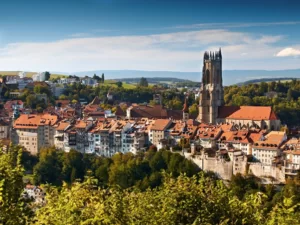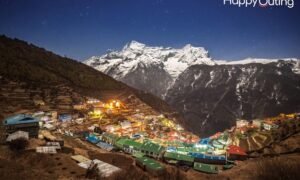
The Swiss city of Fribourg serves as the administrative and economic hub of the canton of the same name. Herzog Berthold IV of Zaehringen established the city in 1157. Fribourg connects the French-speaking and German-speaking regions of Switzerland across the river Sarine, and it is also well-known for its university and its cultural diversity. The city of Fribourg is rich in architectural treasures. With some of Switzerland’s best-preserved defenses and over 200 remaining Gothic-style residences, the Old Town is a must-see for anybody visiting Switzerland. In addition to various churches and the cathedral of St. Nikolaus, there are numerous noble townhouses to see. If you are planning to travel to or stay in Fribourg, you must read this article. This article highlights the most important facts you should know about Fribourg.
Understand about Fribourg
Fribourg (German: Freiburg) is the name of the canton capital in Switzerland. Towards the southwest of Bern, on a bend of the river Sarine (Saane), you’ll find it. The fort was first established in 1157 by Berthold IV, duke of Zähringen, in order to maintain control over a river crossing. In 1277, it was taken over by Rudolf of Habsburg’s sons. It became subject to the Savoy dukes after the Habsburgs left in 1452. Fribourg joined the Swiss Confederation as a full member in 1481 after helping them beat Charles the Bold of Burgundy at Grandson and Morat (now Murten) in 1476. Following its conquest by the French in 1798, Fribourg became a component of the Helvetic Republic and, following Napoleon’s Act of Mediation in 1803, a canton of the Swiss Confederation.
Traveling in Fribourg
It’s possible to see most of the attractions on foot. You will most likely arrive at the SBB station in the contemporary, boring, and even brutalist downtown area. The University may be found 300 metres to the north. If you’re looking for the Old Town, head east. The signs will lead you along Route des Alpes, but the walk down pedestrian-friendly Rue de Lausanne is far more enjoyable. Both paths converge in Place Tilleul, where you may visit the Convent and the Museum of Art History, as well as the Cathedral of St. Nicholas, the Basilica of Notre Dame, the Gutenberg Museum, and the Espace Jean Tinguely Niki de St. Phalle. Keep going downwards past the Cathedral until you reach the bottom of town at the loop of the River Sarine, where the wooden Pont de Berne stands. However, it is mandatory to have Health Insurance in Switzerland and therefore to travel in Fribourg, you will need to get health insurance. You can use TipTop-Health Insurance Comparison so that you can easily buy health insurance online. PrimApp-Health Insurance Comparison can also be used to find and compare health insurances in Switzerland. This tool will help you find the right health insurance with several benefits and minimum costs. However, to get the right price and know which health insurance will be suitable in Fribourg for your needs, you can use a health insurance comparison tool.
Living in Fribourg
On the banks of both Lake Neuchâtel and Lake Morat, remnants of ancient towns have been discovered. The town of Morat (now Murten) was added to the canton in 1803, bringing it to its present size. The canton is made up of regions acquired by its main city, Fribourg. In 1846, it sided with the Sonderbund (a separatist league of Catholic cantons), but by 1847, it had capitulated to the federal troops. As one might expect from a mostly Roman Catholic region, there are many religious institutions there.
Most of the canton consists of rural areas. Key industries include raising cattle and dairying (which includes the production of cheese, most notably in the La Gruyère region). The lush north and central slopes saw a lot of success with market gardening, grains, tobacco, and fruit. Fribourg, Düdingen, and Murten are major hubs for the food processing, machinery, metal product, precision instrument manufacturing, and timber sectors, respectively. You can apply for a credit loan in Switzerland and set up your online business here too. The electricity produced by the district’s power plants is used both locally and internationally. The mountain and lake regions, as well as the city of Fribourg, see the biggest tourist activity. The major train line from Lausanne to Bern provides service to the canton, and numerous smaller lines branch off from it.
Decades-old eatery in Fribourg
In Fribourg, where the Villars chocolate factory has been producing chocolate since 1901, the firm also maintains a cafe that sells solely Villars products (it is unique in Switzerland). Fresh chocolates, such as ganache bonbons (flavored with fruit, spices, etc.), are sold at a counter alongside nationally distributed chocolate bars and napolitains. Sit down with a cup of coffee or hot chocolate and peruse the shelves stocked with Villars coffee beans, chocolate-themed novels, and other treats. Hours are Monday through Friday, 9 a.m. to 5 p.m., and Saturday, 9 a.m. to 12 p.m. (see their website for exact hours).
History of Fribourg
Over 10,000 people called Fribourg home when it became a part of the Swiss Confederation in 1481. Due to its location on a peninsula, the city required many crossings of the Sarine River, the first of which was completed in 1250. During the nineteenth century, Fribourg became well-known for its suspension bridges, which have now been replaced with concrete bridges. The school first opened its doors to students in 1889. According to the 2000 census, there were 35,000 people living in the city proper and 235,000 in the canton of Fribourg as a whole.
Renaissance fountains, along with more modern fountains like the Tinguely Fountain from 1984, may be seen all across the city.
Conclusion
In conclusion, Fribourg is among the major cities in Switzerland for settling and traveling. The above article has highlighted the major facts you should know about Fribourg so that your trip or travel plan can be successful and more informative.







